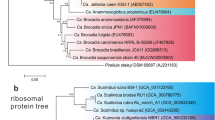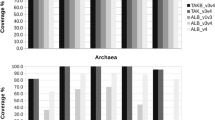Abstract
Three wastewater treatment plants in South Africa were investigated to understand the phylogeny and distribution of Microthrix parvicella using real-time polymerase chain reaction (RT-PCR). The phylogenetic analysis of the 16S rRNA of M. parvicella revealed 98% to 100% homology of South African clones to M. parvicella reported in Genbank. The standard curves for RT-PCR showed R2 values greater than 0.99, accurate for quantification. The relative occurrence of M. parvicella 16S rRNA gene copies in the three wastewater treatment plants was in the range 0% to 3.97%. M. parvicella copies increased when the environmental temperature (≤20°C) and food/microorganism (F/M) ratio was low. The M. parvicella 16S rRNA copies could be positively correlated to the sludge volume index at low temperature. At higher temperature, there was a rapid reduction in M. parvicella population irrespective of other favorable factors, indicating the strong influence of temperature on filamentous proliferation. RT-PCR has potential applications in wastewater treatment plants to monitor sudden shift in the microbial population and assessing the plants efficacy.



Similar content being viewed by others
References
Blackall LL (1994) Molecular identification of activated sludge foaming bacteria. Water Sci Technol 29(7):35–42
Blackall LL, Habers AE, Greenfield PF, Hayward AC (1988) Actinomycete scum problems in Australian activated-sludge plants. Water Sci Technol 20(11/12):493–495
Blackall LL, Stratton H, Bradford D, Del Dot T, Sjrup C, Seviour EM, Seviour RJ (1996) “Candidatus Microthrix parvicella”, a filamentous bacterium from activated sludge sewage treatment plants. Int J Syst Bacteriol 46(1):344–346
Blackbeard JR, Ekama GA, Marais GVR (1986) A survey of filamentous bulking and foaming in activated sludge plants in South Africa. Water SA 14(1):29–34
Clauss F, Hélaine D, Balavoine C, Bidault A (1998) Improving activated sludge floc structure and aggregation for enhanced settling and thickening performances. Water Sci Technol 38(8–9):35–44
Clauss F, Balavoine C, Hélaine D, Martin G (1999) Controlling the settling of activated sludge in pulp and paper wastewater treatment plants. Water Sci Technol 40(11):223–229
Eikelboom DH, Andreasen K (1995) Survey of the filamentous population in nutrient removal plants in four European Countries. TNO-report: TNO-MW-R 95/090. TNO Institute of Environmental Sciences. Delft. The Netherlands
Eikelboom DH, Buijsen HJJ (1983) Microscopic sludge investigation Manual, 2nd edn. TNO Research Institute of Environmental Hygiene, Deft
Eikelboom DH, Andreadakis AD, Andreasen K (1998) Survey of the filamentous population in nutrient removal plants in four European countries. Wat Sci Tech 37(4–5):281–289
Erhart R, Bradford D, Seviour EM, Seviour RJ, Amann RI, Blackall LL (1997) Development and use of fluorescent in situ hybridization probes for the identification and enumeration of ‘Microthrix parvicella’ in activated sludge. Sys Appl Microbiol 20:310–318
Greenberg AE, Clesceri LS, Eaton AD (1992) Standard methods for the examination of water and wastewater, 18th edn. American Public Health Association, Washington
Harms G, Layton AC, Dionisi HM, Gregory IM, Garrett VM, Hawkins SA, Robinson KG, Sayler GS (2003) Real-time PCR quantification of nitrifying bacteria in a municipal wastewater treatment plant. Environ Sci Technol 37(2):343–351
Heid CA, Stevens J, Livak KJ, Williams PM (1996) Real time quantitative PCR. Genome Res 6(10):986–994
Hwang Y, Tanaka T (1998) Control of Microthrix parvicella foaming in activated sludge. Water Res 32(5):1678–1686
Jenkins D, Richard G, Diagger T (1993) Manual on the causes and the control of activated sludge bulking and foaming, 2nd edn. Lewis, USA
Kaetzke A, Jentzsch D, Eschrich K (2005) Quantification of Microthrix parvicella in activated sludge bacterial communities by real-time PCR. Lett Appl Microbiol 40(3):207–211
Knoop S, Kunst S (1998) Influence of temperature and sludge loading on activated sludge settling, especially on Microthrix parvicella. Wat Sci Tech 37(4):27–35
Levantesi C, Rossetti S, Thelen K, Kragelund C, Krooneman J, Eikelboom D, Nielsen PH, Tandoi V (2006) Phylogeny, physiology and distribution of ‘Candidatus Microthrix calida’, a new Microthrix species isolated from industrial activated sludge wastewater treatment plants. Environ Microbiol 8(9):1552–1563
Luxmy BS, Yamamoto K (2003) Investigation of microorganism associated with the foam of a submerged membrane bioreactor in Japan. Microbes and environments 18:62–68
Madoni P, Davoli D, Gibin G (2000) Survey of filamentous microorganisms from bulking and foaming activated-sludge plants in Italy. Water Res 34(6):1767–1772
Mamais D, Nikitopoulos G, Andronikou A, Noutsopoulos C, Giotakis C, Tsimarakis S (2006) Influence of the presence of long chain fatty acids (LCFAs) in the sewage on the growth of Microthrix parvicella in activated sludge wastewater treatment plants. Global NEST J 8:82–88
Martins A, Pagilla K, Heijnen J, van Loosdrencht M (2004) Filamentous bulking sludge-a critical review. Water Res 38(4):793–817
Mayer CL, Palmer CJ (1996) Evaluation of PCR, nested PCR and fluorescent antibodies for detection of Giardia and Cryptospordium species in wastewater. American Soc Microbiol 62(6):2081–2085
Nielsen PH, Roslev P, Dueholm T, Nielsen JL (2002) Microthrix parvicella, a specialized lipid consumer in anaerobic-aerobic activated sludge plants. Water Sci Technol 46(1–2):73–80
Notredame C, Higgins DG, Heringa J (2000) T-Coffee: a novel method for fast and accurate multiple sequence alignment. J Mol Biol 302(1):205–217
Rossetti S, Christensson C, Blackall LL, Tandoi V (1997) Phenotypic and phylogenetic description of an Italian isolate of Microthrix parvicella. J Appl Microbiol 82(4):405–410
Rossetti S, Tomei MC, Nielsen PH, Tandoi V (2005) ‘Microthrix parvicella’, a filamentous bacterium causing bulking and foaming in activated sludge systems: a review of current knowledge. FEMS Microbiol Rev 29(1):49–64
Saitou N, Nei M (1987) The Neighbor-joining method: a new method for reconstructing phylogenetic trees. Mol Biol Evol 4(4):406–425
Sigler W, Turco R (2002) The impact of Chlorothalonil application on soil bacterial and fungal populations as assessed by DGGE. Appl Soil Ecol 21(2):107–118
Vanderhasselt A, Verstraete W (1999) Short-term effects of additives on sludge sedimentation characteristics. Water Res 33(2):381–390
Vansever S, Bossier P, Vanderhasselt A, Beeckman M, Van der Zanden J, Weytjens D, Mingneau C, Verstraete W (1997) Improvement of activated sludge performance by the addition of Nutriflok 50S. Water Res 31(2):366–371
Acknowledgment
This research was financially supported by the National Research Foundation, South Africa and the Durban University of Technology.
Author information
Authors and Affiliations
Corresponding author
Rights and permissions
About this article
Cite this article
Kumari, S.K.S., Marrengane, Z. & Bux, F. Application of quantitative RT-PCR to determine the distribution of Microthrix parvicella in full-scale activated sludge treatment systems. Appl Microbiol Biotechnol 83, 1135–1141 (2009). https://doi.org/10.1007/s00253-009-2013-9
Received:
Revised:
Accepted:
Published:
Issue Date:
DOI: https://doi.org/10.1007/s00253-009-2013-9




